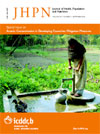
|
The Journal of Health, Population and Nutrition
icddr,b
ISSN: 1606-0997
EISSN: 1606-0997
Vol. 32, No. 1, 2014, pp. 58-67
|
 Bioline Code: hn14008
Bioline Code: hn14008
Full paper language: English
Document type: Research Article
Document available free of charge
|
|
|
The Journal of Health, Population and Nutrition, Vol. 32, No. 1, 2014, pp. 58-67
| en |
Perception of Weight and Health Status among Women Working at Health Centres of Tehran
Dorosty, Ahmad Reza; Mehdikhani, Sepideh; Sotoudeh, Gity; Rahimi, Abbas; Koohdani, Fariba & Tehrani, Parastoo
Abstract
Perception of body-weight status is an important determinant of weight-related behaviours and may affect
the burden of weight disturbances as a public-health problem. No study has assessed self-perception
of the weight status regarding body-fat distribution among health workers to date. The aim of this study
was to evaluate the association of the perception of weight and health status among 542 women working
at health centres of Tehran. We assessed their perceived body-weight and health status and measured
waist- and hip-circumference, weight, and height to calculate waist-to-hip ratio (WHR) as a measure of fat
distribution and body mass index (BMI, kg/m2). Women reported their sociodemographic information,
and the perceived weight and health status were compared with their actual fatness status, defined based
on WHR and BMI, to determine misperception of weight status. Multivariate logistic regression models
were performed to assess the predictive effects of various sociodemographic factors and actual fatness on
the perception of weight and health status. The results showed that more than 40% of women with normal
BMI overestimated their body-weight status while only 15.8% of these women had central obesity. BMI
was the most important variable associated with misperceived weight status as normal-weight women
had significantly more misperception (OR 8.16, 95% CI 4.82-13.82) than overweight/obese women. WHR
did not show any significant relationships with perceived weight status. In addition, perception of health
status was not associated with actual fatness indices. It is concluded, BMI was the main predictor of the
perception of weight status in female employees. The importance of using body-fat distribution in the perceptions
of weight and health status should be emphasized.
Keywords
Body mass index; Health centres; Perception of health status; Perception of weight status; Waist-to-hip ratio; Iran
|
| |
© The Journal of Health, Population and Nutrition
Alternative site location: http://www.jhpn.net
|
|
